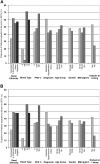Half of kidney transplant candidates who are older than 60 years now placed on the waiting list will die before receiving a deceased-donor transplant
- PMID: 19541814
- PMCID: PMC2709520
- DOI: 10.2215/CJN.01280209
Half of kidney transplant candidates who are older than 60 years now placed on the waiting list will die before receiving a deceased-donor transplant
Abstract
Background and objectives: Waiting times to deceased-donor transplantation (DDTx) have significantly increased in the past decade. This trend particularly affects older candidates given a high mortality rate on dialysis.
Design, setting, participants, & measurements: We conducted a retrospective analysis from the national Scientific Registry of Transplant Recipients database that included 54,669 candidates who were older than 60 yr and listed in the United States for a solitary kidney transplant from 1995 through 2007. Using survival models, we estimated time to DDTx and mortality after candidate listing with and without patients initially listed as temporarily inactive (status 7).
Results: Almost half (46%) of candidates who were older than 60 yr and listed in 2006 through 2007 are projected to die before receiving a DDTx. This proportion varied by individual characteristics: Diabetes (61%), age > or =70 yr (52%), black (62%), blood types O (60%) and B (71%), highly sensitized (68%), and on dialysis at listing (53%). Marked variation also existed by United Network for Organ Sharing region (6 to 81%). The overall projected proportion was reduced to 35% excluding patients who initially were listed as status 7.
Conclusions: These data highlight the prominent and growing challenge facing the field of kidney transplantation. Older candidates are now at significant risk for not surviving the interval in which a deceased-donor transplant would become available. Importantly, this risk is variable within this population, and specific information should be disseminated to patients and caregivers to facilitate informed decision-making and potential incentives to seek living donors.
Figures




References
-
- United States Renal Data System: 2005 Annual Data Report. Available at: http://www.usrds.org/2005/ref/B.pdf. Accessed March 30, 2006
-
- United States Renal Data System: Incidence and Prevalence Rates. Available at: http://www.usrds.org/2008/pdf/V2_02_2008.pdf. Accessed May 18, 2009.
-
- Wolfe RA, Ashby VB, Milford EL, Ojo AO, Ettenger RE, Agodoa LY, Held PJ, Port FK: Comparison of mortality in all patients on dialysis, patients on dialysis awaiting transplantation, and recipients of a first cadaveric transplant. N Engl J Med 341: 1725–1730, 1999 - PubMed
-
- Oniscu GC, Brown H, Forsythe JL: How old is old for transplantation? Am J Transplant 4: 2067–2074, 2004 - PubMed
-
- United States Renal Data System: 2008 Annual Data Report. Available at: http://www.usrds.org/2008/ref/E_Transplantation_Process_08.pdf. Accessed November 4, 2008 - PubMed
MeSH terms
Substances
LinkOut - more resources
Full Text Sources
Other Literature Sources
Medical
Miscellaneous

